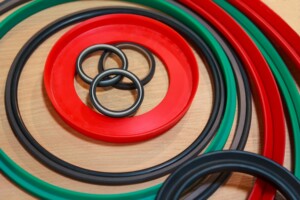
The quest for robust and long-lasting materials is ceaseless in the industrial landscape. Among these, industrial rubber stands out for its versatility and widespread use. However, just like any other material, it too has an Achilles’ heel–– that is, its durability under harsh conditions.
To make sure it stays strong and capable of withstanding the elements, manufacturers must make sure to modify their production process. Prepare to step into the fascinating world of material science and uncover how subtle changes in the manufacturing process can dramatically increase the durability of this ubiquitous material.
1. Increasing the Crosslinking Density
Increasing the crosslinking density refers to augmenting the number of crosslinks –– bonds connecting the long chains of polymers that form rubber. These crosslinks act as bridges, enhancing the rubber’s rigidity and tensile strength.
This creates a three-dimensional network that makes the rubber more resistant to deformation and degradation over time. As a result, the rubber becomes more resistant to stretching and deformation, which is particularly crucial under heavy-duty industrial conditions.
But how exactly can manufacturers increase the crosslinking density? The process relies on vulcanization, a chemical process that involves treating rubber with heat and sulfur. The mesh structure created is more resistant to various forms of degradation, including thermal, oxidative, and mechanical degradation.
For instance, conveyor belts created with increased crosslinking density can remain undamaged even when exposed to high temperatures and heavy loads. These conveyor belts can also be used in highly corrosive production environments, as the increased crosslinking density provides that additional protection.
2. Reinforcing With Fibers
Fiber reinforcement involves integrating fibrous materials into the rubber during the production process. These fibers, which can be made from various materials like nylon, polyester, or even carbon, work by distributing applied stress over a wider area within the rubber matrix, reducing the impact of strain on any one point.
This way, the rubber is less likely to tear or deform under heavy loads or high pressure, a common issue in industrial environments. The fibers essentially act as a mesh within the rubber, holding it together and preventing it from falling apart under stress.
Not only does fiber reinforcement increase resilience to mechanical stress, but it also improves the rubber’s thermal and oxidative stability. Different types of fibers can offer different types of protection. For example, aramid fibers are known for their exceptional heat resistance and are often used in applications where the rubber will be exposed to high temperatures.
On the other hand, glass fibers offer excellent elasticity resistance to stretching, making them suitable for use in environments where the rubber is exposed to high levels of tension. So as you can now tell, it helps to specify the environment of use so you can select the right type of fiber for reinforcement.
3. Improving the Compounding Process
The compounding process is where the various ingredients that make up the rubber compound are mixed together. Interestingly, the quality of the mixing process can have a big impact on the durability of the finished product.
One way to improve the compounding process is to use specialized equipment, such as internal mixers or extruders. These machines can provide better dispersion of the ingredients, resulting in a more uniform and consistent rubber compound.
Internal mixers, for instance, have a unique rotating arm that ensures a more thorough and even dispersion of the ingredients. Extruders, on the other hand, create an even more homogeneous compound by heating and pushing it through a series of narrow passages. The result? A rubber material that is less susceptible to variations in temperature, stress, and other environmental factors.
The compounding process can also be improved using chemical agents, such as dispersing agents. These chemicals help to keep particles afloat in the mixture, resulting in better homogeneity and preventing clumping or agglomeration. In other words, they help increase the rubber compound’s uniformity by reducing particle size and keeping them distributed evenly throughout.
Need more information on how experts make industrial rubber more durable? Contact Accurate Products Inc. to understand how we can help you achieve a more robust and resilient product. With our years of experience and specialized equipment, we can guarantee superior durability and strength across the board.